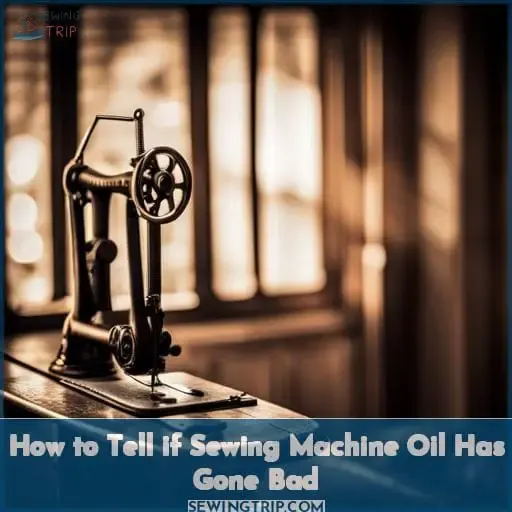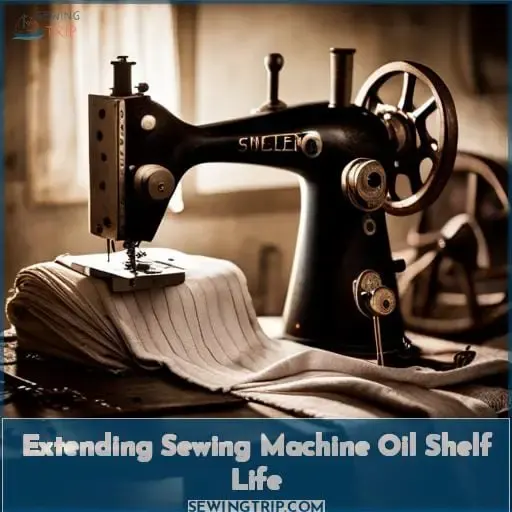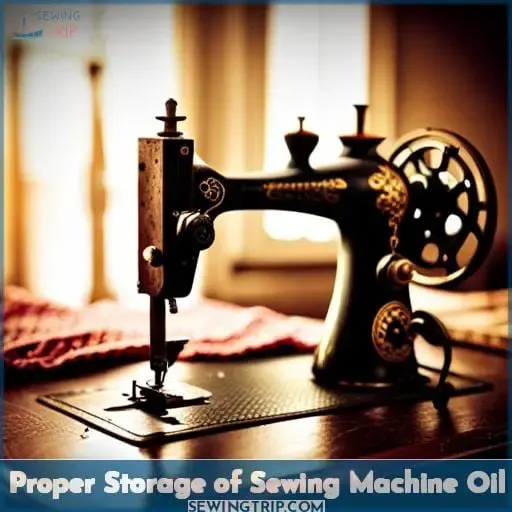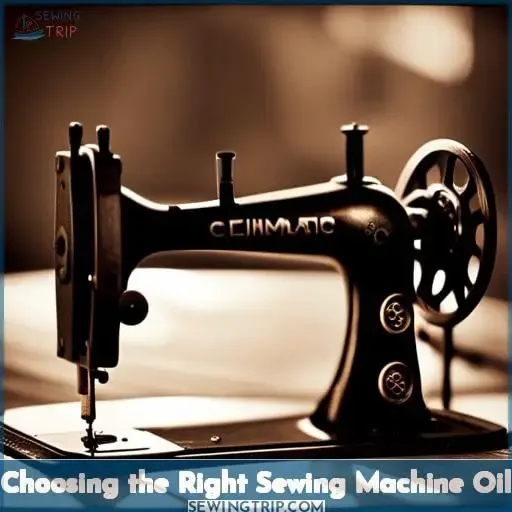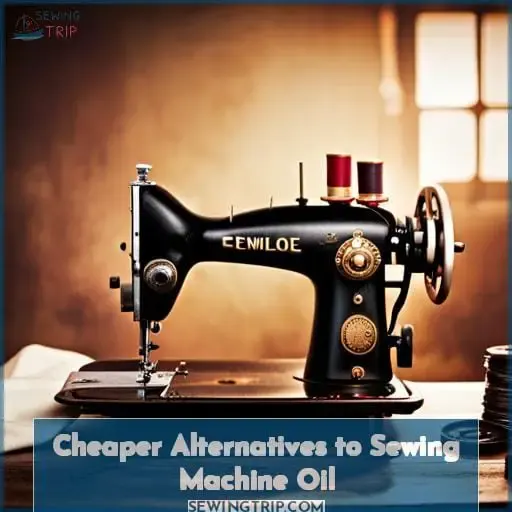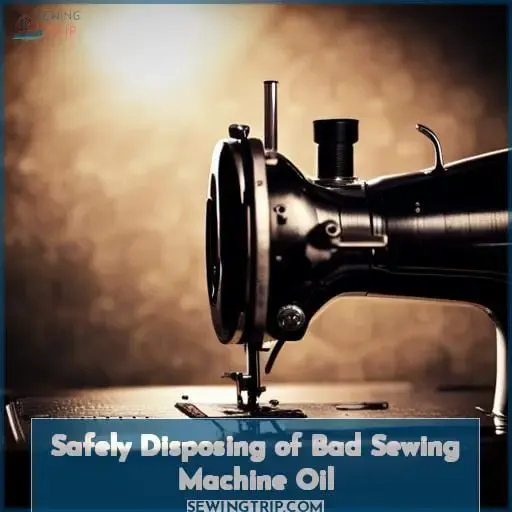This site is supported by our readers. We may earn a commission, at no cost to you, if you purchase through links.
 I bet you’re wondering if that bottle of sewing machine oil from grandma’s attic is still good to use. Well, hold your horses before you start oiling those dusty cams and gears! Just because it’s been sitting there since 1975 doesn’t automatically make that oil go rancid.
I bet you’re wondering if that bottle of sewing machine oil from grandma’s attic is still good to use. Well, hold your horses before you start oiling those dusty cams and gears! Just because it’s been sitting there since 1975 doesn’t automatically make that oil go rancid.
You’d be surprised at how well kept sewing machine oil can stay fresh when stored properly. But there are some signs of aging to look for before pouring decades-old oil where metal meets metal. Let’s walk through what makes sewing machine oil expire and how you can make that vintage bottle last longer next time.
Don’t let old sewing machine oil lead you into a seized up, rusty mess. Regular maintenance and proper storage keeps your machine running smoothly for years. And nothing feels better than breathing life into grandma’s old workhorse using the oil she left behind.
With a few tips on identifying and storing good oil, you’ll keep those gears turning like she just filled the canister yesterday.
Table Of Contents
Key Takeaways
- Choose the right sewing machine oil type for your specific machine.
- Store sewing machine oil properly in opaque, sealed containers away from temperature extremes.
- Monitor oil quality by checking clarity, texture, and odor.
- Replace sewing machine oil around every 5 years for optimal performance.
What is Sewing Machine Oil?
To prevent depreciation of performance, it’s vital you routinely inspect the lubricant’s clarity, scent, and viscosity. Sewing machine oil is a light, transparent lubricant designed specifically for sewing machines.
You’ll find natural, synthetic, and mineral oils. Synthetic oils like silicone can handle plastic parts but may cost more.
Mineral oils are affordable yet effective. You want oil that retains clarity and flows easily. Transparent containers help monitor quality over time. Don’t purchase more than you’ll use in around 5 years.
Keep oil in a dark, room-temperature area. When oiling, avoid over-application that could stain fabric. Use a dropper, funnel, or the oil bottle for hard-to-reach spots. Apply just a few drops to shafts, hook, needle bar – wherever metal contacts metal.
Substitutes like household oils can damage machines. With the right oil and routine care, your machine will run smoothly for many yards to come.
How to Tell if Sewing Machine Oil Has Gone Bad
Check your eyelids, hon, ’cause color changes in that oil likely means it’s time for somethin’ fresh. As you feed that fabric the refreshment of a needlework, keep a surgeon’s eye on the translucent sheen of your oiler.
Cloudiness creepin’ in? That golden glow now a grungy tan? These fluid clues whisper it’s time to toss yesterday’s silk syrup and welcome the new.
With fresh, see-through oil blessin’ your machine, you give your works that slippery embrace to hum sweet as honey. And if her song grows rough, oil opaque or machine shriekin’, show yourself and your machine some love by startin’ fresh with oil that’s clear and clean.
Prolong your equipment’s life by regularly inspectin’ oil quality, switchin’ out degraded fluid before sewin’ issues arise. So stay ready to toss tired oils and keep your machines refreshed, for degraded oil leads to damaged parts.
Give your equipment the care it deserves – keep oil fresh and sewin’ smooth.
Extending Sewing Machine Oil Shelf Life
To make sewing machine oil last longer, you must protect it from enemies like heat, air, and light. Store oil in a cool, dark place, tightly sealed in its original container or one made of opaque plastic or metal.
Avoid direct sun exposure which can quickly degrade oil. Some favor mineral oils for longevity, while others opt for less viscous synthetics, but the real power’s in how you care for any oil.
Monitor its clarity and viscosity. Dispose of cloudy or gummy oil that leaves residue. If unsure about using an old oil, try a tiny test amount on hidden machine parts. With reasonable care, sewing machine oil can work smoothly for years, saving you money.
But neglect lets its quality fade fast. Stay vigilant against threats in storage, and your oil will keep your machine humming.
Proper Storage of Sewing Machine Oil
Keep it in an air tight container away from direct sunlight or extreme temperatures to prolong its lifespan. You want to store your sewing machine oil properly to maximize shelf life. Optimal storage conditions help maintain oil quality and performance for longer.
Find an opaque, sealed bottle or one with minimal air exposure. Keep it somewhere dark, dry, and around room temperature if possible. Avoid placing it near heaters, vents, or anywhere with temperature fluctuations.
Direct light encourages oxidation while cold temps make the oil too viscous. Check storage recommendations on the label too for specialized oils. Don’t forget to wipe and re-cap tightly after each use. With proper care taken when storing, quality sewing machine oil should retain ideal viscosity and lubrication abilities for extended periods before it goes bad or needs replacing based on use and oil ratings.
Monitoring appearance, feel, and performance will indicate when it’s time for a new bottle.
Choosing the Right Sewing Machine Oil
When shopping for sewing machine oil, remember that not all oils are created equal. Choose the right oil type for your machine, monitor the oil’s quality regularly, and store it properly to maintain its integrity — this will help keep your machine running smoothly for years to come.
Choosing Oil Type
Carefully weigh your options when choosing the type of oil for prolonging your machine’s life. Mineral oils are economical and effective, but synthetic oils suit plastic parts and reduce over-oiling risks.
However, synthetics come at a higher price. Consider factors like your machine’s needs and maintenance habits when weighing your options. Monitoring oil clarity, texture and lack of odor determines reapplication time, regardless of oil type, if done properly and consistently.
Both mineral and synthetic oils can promote your machine’s longevity with proper usage and storage techniques. Consider environmental factors as well – some natural oils are more eco-friendly.
– Monitoring Oil Quality
Check your oil often to spot any changes that signal it’s going bad. Routinely inspect the oil in transparent containers for clarity, texture, smell, and color. Cloudiness, thickening, odd odors, or darkening can indicate degradation. Storing oil properly helps preserve quality.
Keep it sealed and out of sunlight in a stable environment. With reasonable care, the quality of sewing machine oil can last around five years. But if you notice troubling signs, replace it, regardless of age, to protect your machine.
– Proper Oil Storage
You’ll prolong oil life by storing it away from sunlight in a closed, room temperature spot.
- Keep oil in opaque or darkened bottles since light degrades oil.
- Store oil at room temperature around 70°F to prevent thickening or thinning.
- Seal bottles tightly and check for leaks to avoid contamination.
Modern sewing machines require proper oil storage for peak performance. Following basic maintenance tips helps prolong shelf life.
Cheaper Alternatives to Sewing Machine Oil
Manifold users scrimp on special oils, substituting cheaper grocery store finds. Some DIY oil alternatives seem cost effective in the short term but can ultimately damage your machine.
- Cooking Oils
- Baby Oil
- Vegetable Oil
- WD-40
Though more affordable, these oils and solvents can collect debris, gum up mechanisms, and lead to long term maintenance issues. Investing in quality sewing machine oil specially formulated for your make and model is ideal.
With proper storage away from light and moisture, one bottle can last years. For guidance in selecting the optimal oil for your machine’s needs, consult an expert technician or brand representative like Goldstar Tool.
Proper lubrication preserves your machine’s performance and extends its lifetime.
Safely Disposing of Bad Sewing Machine Oil
You’ve used that sewing machine oil for years, but now it’s time to retire it. I know you’re hesitant to just pour it down the drain, worried about the environmental impact.
Used oil recycling programs allow you to safely dispose of old sewing machine oil without harming the planet. Look for an oil recycling center in your area that takes small amounts of household oil.
If no center is available, allow the used oil to soak into an absorbent material like cat litter or rags. Once saturated, bag it up and put it in the regular trash. Never dump oil directly into landfills or sewers.
With a little care and research, you can keep used sewing machine oil from polluting while finding an ethical way to dispose of it. Handling dangerous materials like oil safely shows you value the wellbeing of the planet and community.
Conclusion
Like a finely tuned sewing machine, your machine’s lifespan relies on proper oiling. By monitoring oil quality, storing it properly, and using the right type, you’ll stitch perfection for years to come.
But if you see darkening, congealing, or notice unpleasant odors in your sewing machine oil, it’s time to freshen it up. With some tender loving care and high-quality oil, your sewing machine will purr for miles of stitching yet to come.
Don’t economize on oil – rely on it as lubricating the gears of your creative expression.


